| |
Spirals
Andromeda-M 31
Where are the obvious clouds of gas and dust? How
do the colors of stars in the arms compare to the colors of stars in the
bulge?
The Andromeda galaxy M31 (and its companion
galaxies M32 and M110)
450 x 2970 pixels
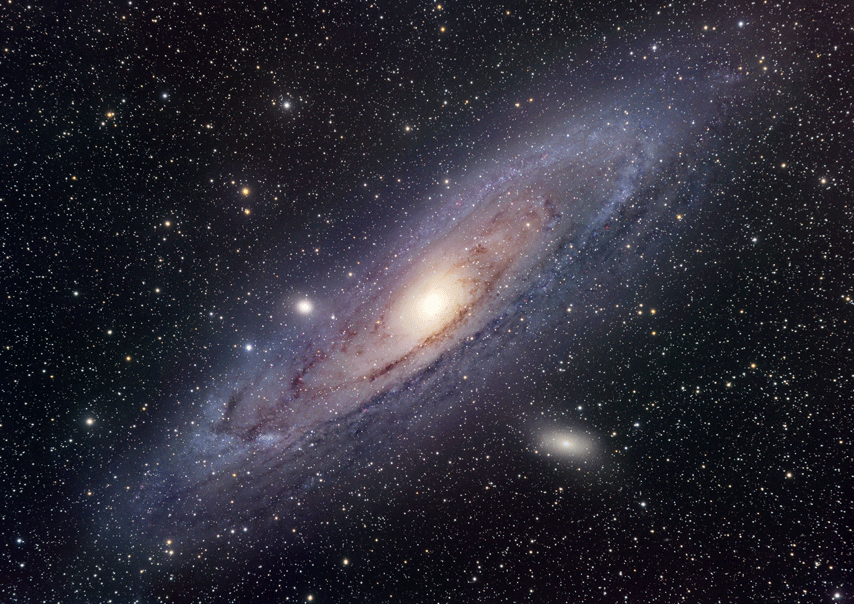
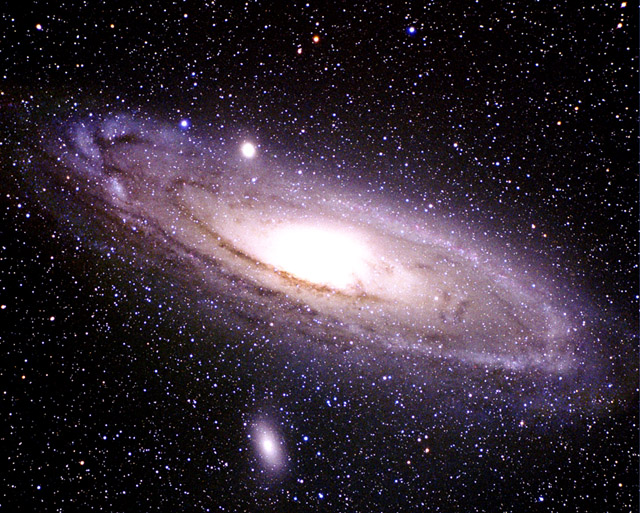
1490 x 983 pixels - Andromeda Galaksisi
Closeup of M31 and one of its companion galaixes,
an elliptical galaxy called M32
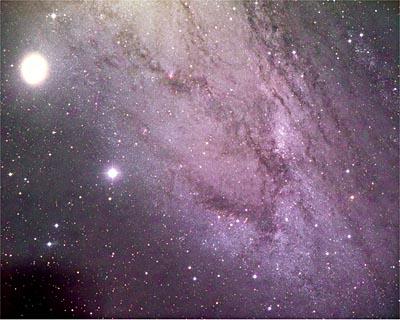
The Andromeda Galaxy
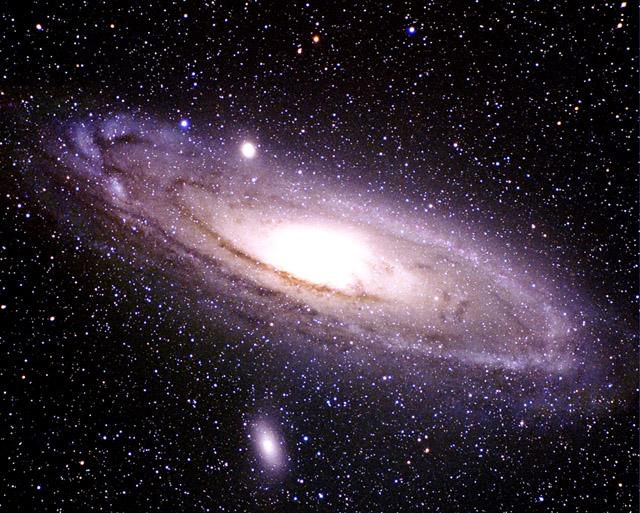
|
Above, a wide-angle view of M31 (the
Andromeda Galaxy), the nearest large galaxy to ours, a little
over 2 million light years away. M31 is very similar to our own
galaxy, but a little larger and more massive. Because of its
large size and relatively close distance, the galaxy is easily
visible as a faint fuzz-ball without optical aid in a dark sky;
but in city lights, is only a faint smudge even in a large
telescope. The actual size of the galaxy spans several degrees,
but is only visible with long exposures in dark skies. The fuzzy
elliptical balls near M31 (M32, above, and NGC205, below) are
dwarf elliptical galaxies, which are companions or satellites of
M31. The image below is a closer view, emphasizing the various
colors of regions with different kinds of stars, by using
different choices for the colors assigned to black-and-white
images taken at various wavelengths (click on the image for a
still closer view). |
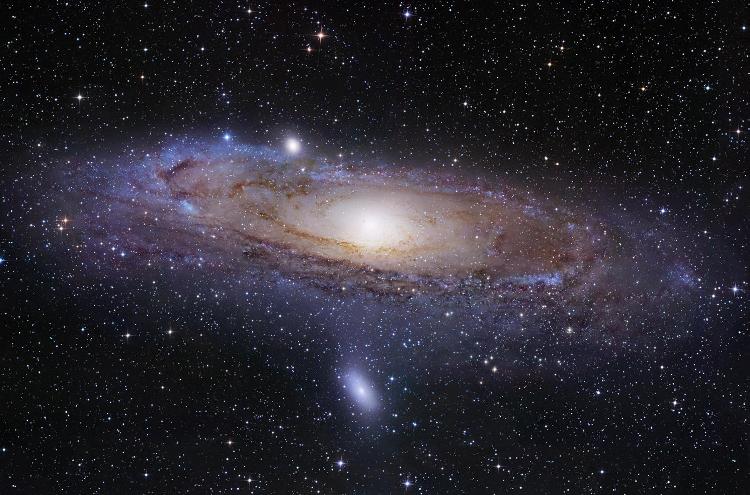
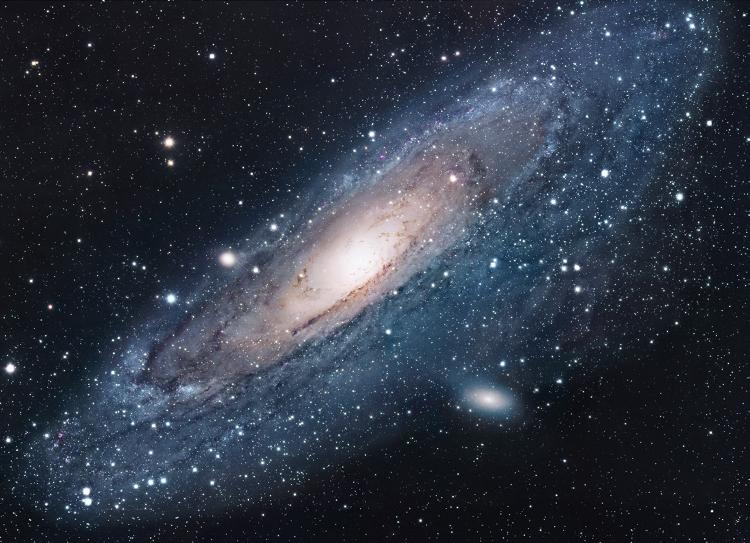
|
In the outer portions of galaxies, stars
are further apart than in the inner regions, making the surface
brightness too low for easy detection. Using longer exposures,
as in the above image of M31, shows that the disc extends
considerably further than might usually be thought. Very long
exposures can even reveal the halo, which typically extends two
to three times the distance occupied by the disc. Conversely,
short exposures can reveal details in the core of the galaxy,
which is grossly overexposed in most images. It is in this way
that we are able to estimate the distribution of stars, which
are typically light weeks apart near the center of the nucleus,
light months apart in the outer parts of the nucleus, light
years apart in the disc, and light decades apart in the halo.
Andromeda Gökadası
(ayrıca Messier 31, M31, ve NGC 224 olarak da bilinir) Andromeda
Takımyıldızında bulunan bir sarmal gökadadır. Spitzer Uzay
Teleskopundan ele edilen verilere göre 1 trilyon yıldıza ev
sahipliği yapmaktadır. 2006 ölçümlerine göre Samanyolu,
Andromeda'nın kütlesinin ancak ~80%'ine sahiptir. Andromeda'nın
bir diğer özelliği ise, çıplak göz ile Yer'den görülebilen en
uzak gök cismi olmasıdır. Ayrıca Samanyolu'na en yakın büyük
gökadadır.
| Takımyıldız |
Andromeda |
| Sağ açıklık |
00 saat 42 dakika 44.3 saniye |
| Dik açıklık |
+41° 16′ 9″ |
| Kırmızıya Kayma |
−301 ± 1 km/s |
| Mesafe |
2.53 ± 0.07 milyon ışık yılı |
| Gökada sınıfı |
SA(s)b |
| Açısal çap (v) |
190′ × 60′ |
| Görünür parlaklık |
4.36 |
|
Ek özellikler |
Samanyolu'na
en yakın gökada |
|
|
|
Astronomi
Galaxy Resimler
Nebula Resimler
Yıldız Kümeleri Resimleri
Astrophotography
Hiçbir
yazı/ resim izinsiz olarak kullanılamaz!! Telif hakları uyarınca
bu bir suçtur..! Tüm hakları
Çetin BAL'
a aittir. Kaynak gösterilmek şartıyla siteden alıntı yapılabilir.
The Time Machine Project © 2005
Cetin BAL - GSM: +90 05366063183 - Turkiye / Denizli
Ana Sayfa /
index
/ Roket
bilimi /  E-Mail
/
CetinBAL
/
UFO Technology
E-Mail
/
CetinBAL
/
UFO Technology
Kuantum Fizigi /
New World Order ( Macro Philosophy )
Copyright(c) 2003 - 2006 -
Cetin BAL - All rights reserved. |
|


![]() E-Mail
/
CetinBAL
/
UFO Technology
E-Mail
/
CetinBAL
/
UFO Technology


